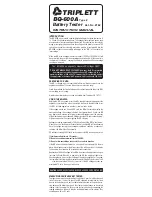
INTRODUCTION:
The BQ-600A is an accurate, hand held digital voltmeter designed to measure 6,
12, 24 and 48 volt vehicular batteries. The voltages thus measured can be used
as an indicator of the state of charge of the battery. Because faults in the vehicle’s
wiring or charging system can cause the voltage on the battery to exceed 100
volts when the vehicle is running, protection circuitry is incorporated into the
BQ-600A to reduce the possibility of damage to the “BQ” in the event of an
“overvoltage”.
When the BQ is fed a voltage in excess of about +70VDC or 70VAC RMS, it will
beep to inform the user that an overvoltage condition exists. At the same time,
the meter will “shut down”, causing the display to go blank, until the overvoltage
condition is removed.
The BQ-600A is designed to measure DC voltages ONLY!
IT WILL NOT MEASURE AC VOLTAGES! However, the BQ is protected
from damage caused by the application of AC voltage, up to a
maximum voltage of 240 volts. This means that it is protected against
the application of household AC power, which is nominally 120 volts.
PREPARING FOR USE:
The BQ is shipped with the tapered metal terminal already screwed into the
negative connection of the case. Make sure this terminal is snug.
Screw the provided test lead into the positive connection on the top of the BQ’s
case, making sure it is snug.
A replacement terminal and test lead is available from Triplett as PN 79-727.
USING THE BQ-600A:
Holding the BQ in one hand, press the BQ’s tapered terminal firmly against the
negative (-) terminal of the circuit to be tested, while, with the other hand, press
the BQ’s test lead against the positive (+) terminal to be tested.
If the voltage is between 5.8 and 60.0 volts, the BQ will accurately display the
measured voltage. If the voltage is below 5.8 but greater than 4.0 volts, the BQ
may display the measurement at greatly reduced brightness, but the accuracy
of the measurement is questionable. Voltages less than 2.0 volts cannot be prop-
erly measured and will not even light up the BQ’s display.
Voltages exceeding approximately 70.0 volts will cause the BQ to “shut down”.
When this occurs, the display will shut off entirely, and the BQ will start beeping.
Once the voltage causing the overrange or shutdown condition is reduced or
removed, the BQ will function normally.
DC voltages exceeding 240V should not be applied to the BQ or damage may result.
1) Limit measuring time to 30 seconds.
2) Do not exceed measurement limit of 60 VDC.
3) Do not allow overvoltage to exceed 30 seconds in duration.
If the BQ is hooked up backwards (i.e., connected in reverse polarity), the dis-
play will be blank except for the Minus sign at the left hand side of the display.
The beeper will not sound with a reverse polarity connection.
Application of 60Hz AC voltage to the BQ will not cause damage if the voltage is
less than 240 volts. When AC is applied to the BQ, the display will light at re-
duced brightness; however, the reading will display as negative (i.e., the nega-
tive symbol will be lit up) and the displayed value will typically be less than 1 volt
. . . even when more than 100 volts is present! If the AC voltage exceeds ap-
proximately 70 volts, the beeper will sound.
CAUTION:
LARGE AC VOLTAGES WILL READ AS ZERO VOLTS ON THE BQ!
MEASURING VEHICULAR BATTERIES:
To properly measure a vehicular battery, the battery’s “posts” must be clean and
free of corrosion. It is best to touch the BQ’s tapered terminal and test lead
directly to the battery posts, not the cable clamps attached to the posts. Corro-
sion between the battery posts and the clamps could produce an inaccurate
reading. In fact, knowing this, the user can test for corrosion by comparing the
reading obtained on the posts with the reading obtained on the clamps. They
should agree within
±
0.1 volts.
BQ-600A
Type 2
Battery Tester
Cat. No. 3194
INSTRUCTION MANUAL
TRIPLETT




















